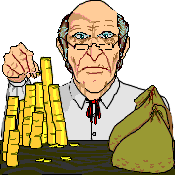
An introduction to the game
 |
Taxman Quick Note An introduction to the game |
|
|||
| Taxman is a game of
math strategy. It is very simple to learn, but hard to win. The game consists of a set of numbers in neutral territory (yellow area in the center of board). In the game, the numbers are represented as bags of money (the central theme of the interface). You and the computer take turns choosing numbers. If you choose a number, you get the number of points equivilant to that number. Your opponent (the Taxman) gets the factors of that number. When the Taxman chooses, you get the factors of his choice. Numbers that are chosen go to each player's respective side of the board. The factors "fly" to the opponent's side of the board. Whoever has the most points (chosen numbers plus factors) after the last number is chosen, wins. |
|||
| User Interface | |||||||
| Score Area | The score area sits
just above the grid of numbers (money bags). On the left is your side of the board,
and you can see your score. On the right is the Taxman's side of the board, and you can see his score. In the middle is the neutral territory where you can see the quantity of number left in the game |
||||||
| Playing Grid | In the center of the
screen is the playing grid. Here you can choose numbers by clicking on the bag with
the number you want to choose. The number will move to your side of the board and the factors will move to the Taxman's side of the board. You must then wait while the Taxman makes his choice. |
||||||
| Button Area | On the lower left of
the board are two buttons and a checkbox. The checkbox sets the person who goes first. If you want to go first, make sure this checkbox has a check when you press New Game. The New Game button starts a new game. The board is refreshed and any options changes take effect. You may start a new game in the middle of the Taxman's search without causing any harm. The search will simply stop. The Options button brings up the game options. You may view and change the game options at any time; however, option changes do not take effect until the next new game. |
||||||
| Advantage Area | The lower center of
the board shows the player advantage. There are two progress bars with numbers in
the middle of the bars. The upper bar shows the current difference in scores. If you are winning, the bar extends toward your side of the board and the number is negative (Taxman is loosing). The lower bar shows the score difference that the Taxman forsees in the future. Again, if the bar extends toward your side, you should be winning in the future. If it extends toward the Taxman, then there is a good chance you will loose (but comebacks are possible). The number of moves ahead the Taxman looks before choosing a number is determined in the options. |
||||||
| Statistics Area | The game reports back
statistics when the Taxman is searching. Over on the bottom left a box labeled
"Thinking" appears when the Taxman is choosing his move. The number
represents the number of seconds he has been thinking. The other statistics are related to the search technique used. The program uses the well-known minimax algorithm to find the optimal move at a given depth. You don't need to know what the statistics mean to play the game, but here is what they represent if you are curious:
|
||||||
| Options Panel | The game has several
options which you can change. Almost all are clustered under the Options screen.
You can reach the options screen by pressing the Options button. There are five different options for you to choose from:
|
| Game Playing Tips | |||||||||||||||||||||
|
|||||||||||||||||||||
| To the Top |